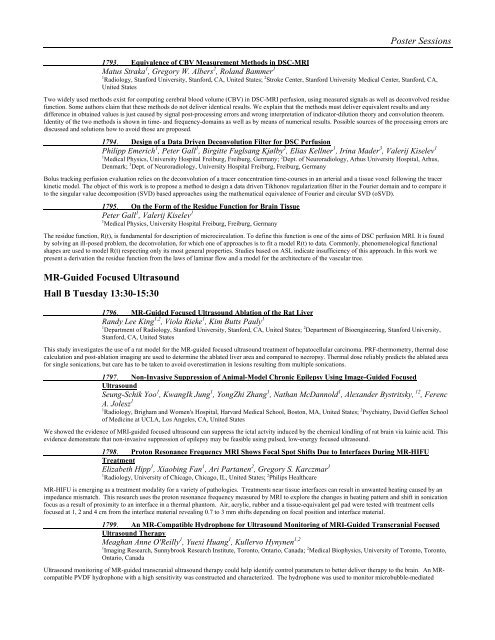TRADITIONAL POSTER - ismrm
TRADITIONAL POSTER - ismrm
TRADITIONAL POSTER - ismrm
You also want an ePaper? Increase the reach of your titles
YUMPU automatically turns print PDFs into web optimized ePapers that Google loves.
Poster Sessions<br />
1793. Equivalence of CBV Measurement Methods in DSC-MRI<br />
Matus Straka 1 , Gregory W. Albers 2 , Roland Bammer 1<br />
1 Radiology, Stanford University, Stanford, CA, United States; 2 Stroke Center, Stanford University Medical Center, Stanford, CA,<br />
United States<br />
Two widely used methods exist for computing cerebral blood volume (CBV) in DSC-MRI perfusion, using measured signals as well as deconvolved residue<br />
function. Some authors claim that these methods do not deliver identical results. We explain that the methods must deliver equivalent results and any<br />
difference in obtained values is just caused by signal post-processing errors and wrong interpretation of indicator-dilution theory and convolution theorem.<br />
Identity of the two methods is shown in time- and frequency-domains as well as by means of numerical results. Possible sources of the processing errors are<br />
discussed and solutions how to avoid those are proposed.<br />
1794. Design of a Data Driven Deconvolution Filter for DSC Perfusion<br />
Philipp Emerich 1 , Peter Gall 1 , Birgitte Fuglsang Kjølby 2 , Elias Kellner 1 , Irina Mader 3 , Valerij Kiselev 1<br />
1 Medical Physics, University Hospital Freiburg, Freiburg, Germany; 2 Dept. of Neuroradiology, Arhus University Hospital, Arhus,<br />
Denmark; 3 Dept. of Neuroradiology, University Hospital Freiburg, Freiburg, Germany<br />
Bolus tracking perfusion evaluation relies on the deconvolution of a tracer concentration time-courses in an arterial and a tissue voxel following the tracer<br />
kinetic model. The object of this work is to propose a method to design a data driven Tikhonov regularization filter in the Fourier domain and to compare it<br />
to the singular value decomposition (SVD) based approaches using the mathematical equivalence of Fourier and circular SVD (oSVD).<br />
1795. On the Form of the Residue Function for Brain Tissue<br />
Peter Gall 1 , Valerij Kiselev 1<br />
1 Medical Physics, University Hospital Freiburg, Freiburg, Germany<br />
The residue function, R(t), is fundamental for description of microcirculation. To define this function is one of the aims of DSC perfusion MRI. It is found<br />
by solving an ill-posed problem, the deconvolution, for which one of approaches is to fit a model R(t) to data. Commonly, phenomenological functional<br />
shapes are used to model R(t) respecting only its most general properties. Studies based on ASL indicate insufficiency of this approach. In this work we<br />
present a derivation the residue function from the laws of laminar flow and a model for the architecture of the vascular tree.<br />
MR-Guided Focused Ultrasound<br />
Hall B Tuesday 13:30-15:30<br />
1796. MR-Guided Focused Ultrasound Ablation of the Rat Liver<br />
Randy Lee King 1,2 , Viola Rieke 1 , Kim Butts Pauly 1<br />
1 Department of Radiology, Stanford University, Stanford, CA, United States; 2 Department of Bioengineering, Stanford University,<br />
Stanford, CA, United States<br />
This study investigates the use of a rat model for the MR-guided focused ultrasound treatment of hepatocellular carcinoma. PRF-thermometry, thermal dose<br />
calculation and post-ablation imaging are used to determine the ablated liver area and compared to necropsy. Thermal dose reliably predicts the ablated area<br />
for single sonications, but care has to be taken to avoid overestimation in lesions resulting from multiple sonications.<br />
1797. Non-Invasive Suppression of Animal-Model Chronic Epilepsy Using Image-Guided Focused<br />
Ultrasound<br />
Seung-Schik Yoo 1 , KwangIk Jung 1 , YongZhi Zhang 1 , Nathan McDannold 1 , Alexander Bystritsky, 12 , Ferenc<br />
A. Jolesz 1<br />
1 Radiology, Brigham and Women's Hospital, Harvard Medical School, Boston, MA, United States; 2 Psychiatry, David Geffen School<br />
of Medicine at UCLA, Los Angeles, CA, United States<br />
We showed the evidence of MRI-guided focused ultrasound can suppress the ictal actvity induced by the chemical kindling of rat brain via kainic acid. This<br />
evidence demonstrate that non-invasive suppression of epilepsy may be feasible using pulsed, low-energy focused ultrasound.<br />
1798. Proton Resonance Frequency MRI Shows Focal Spot Shifts Due to Interfaces During MR-HIFU<br />
Treatment<br />
Elizabeth Hipp 1 , Xiaobing Fan 1 , Ari Partanen 2 , Gregory S. Karczmar 1<br />
1 Radiology, University of Chicago, Chicago, IL, United States; 2 Philips Healthcare<br />
MR-HIFU is emerging as a treatment modality for a variety of pathologies. Treatments near tissue interfaces can result in unwanted heating caused by an<br />
impedance mismatch. This research uses the proton resonance frequency measured by MRI to explore the changes in heating pattern and shift in sonication<br />
focus as a result of proximity to an interface in a thermal phantom. Air, acrylic, rubber and a tissue-equivalent gel pad were tested with treatment cells<br />
focused at 1, 2 and 4 cm from the interface material revealing 0.7 to 3 mm shifts depending on focal position and interface material.<br />
1799. An MR-Compatible Hydrophone for Ultrasound Monitoring of MRI-Guided Transcranial Focused<br />
Ultrasound Therapy<br />
Meaghan Anne O'Reilly 1 , Yuexi Huang 1 , Kullervo Hynynen 1,2<br />
1 Imaging Research, Sunnybrook Research Institute, Toronto, Ontario, Canada; 2 Medical Biophysics, University of Toronto, Toronto,<br />
Ontario, Canada<br />
Ultrasound monitoring of MR-guided transcranial ultrasound therapy could help identify control parameters to better deliver therapy to the brain. An MRcompatible<br />
PVDF hydrophone with a high sensitivity was constructed and characterized. The hydrophone was used to monitor microbubble-mediated















